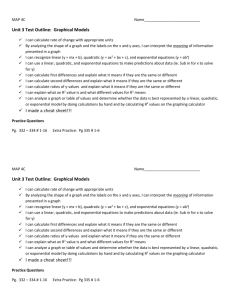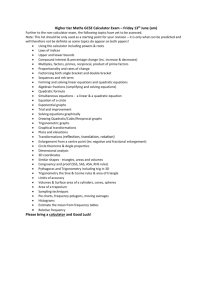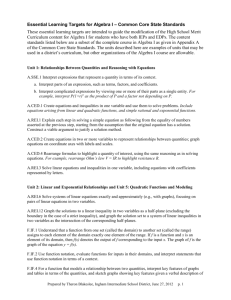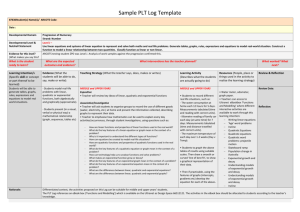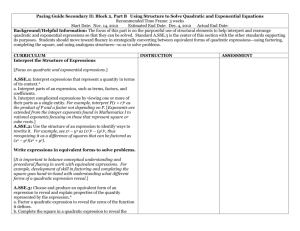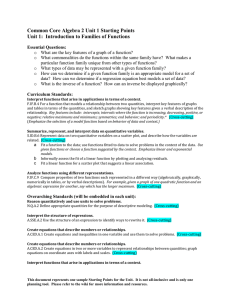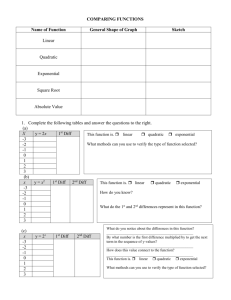Pacing Guide: Secondary Math II, Instructional Block 1, Part A
advertisement
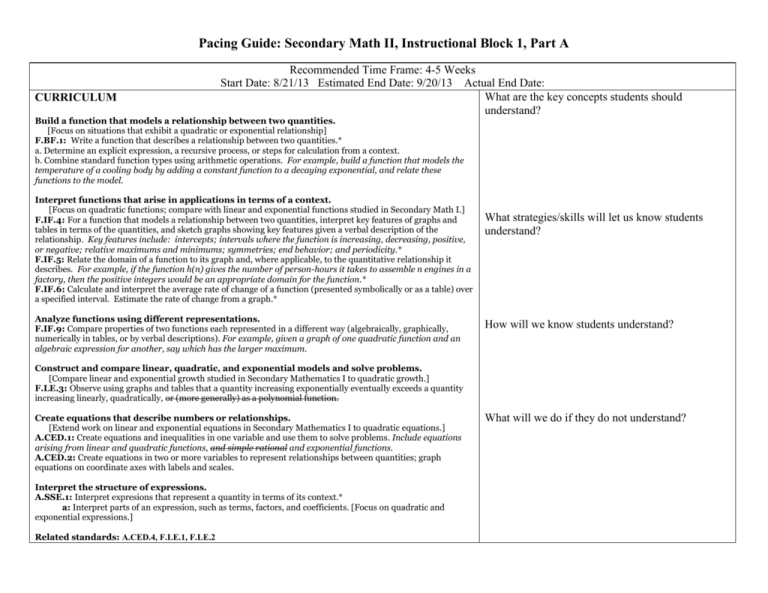
Pacing Guide: Secondary Math II, Instructional Block 1, Part A CURRICULUM Recommended Time Frame: 4-5 Weeks Start Date: 8/21/13 Estimated End Date: 9/20/13 Actual End Date: What are the key concepts students should understand? Build a function that models a relationship between two quantities. [Focus on situations that exhibit a quadratic or exponential relationship] F.BF.1: Write a function that describes a relationship between two quantities.* a. Determine an explicit expression, a recursive process, or steps for calculation from a context. b. Combine standard function types using arithmetic operations. For example, build a function that models the temperature of a cooling body by adding a constant function to a decaying exponential, and relate these functions to the model. Interpret functions that arise in applications in terms of a context. [Focus on quadratic functions; compare with linear and exponential functions studied in Secondary Math I.] F.IF.4: For a function that models a relationship between two quantities, interpret key features of graphs and tables in terms of the quantities, and sketch graphs showing key features given a verbal description of the relationship. Key features include: intercepts; intervals where the function is increasing, decreasing, positive, or negative; relative maximums and minimums; symmetries; end behavior; and periodicity.* F.IF.5: Relate the domain of a function to its graph and, where applicable, to the quantitative relationship it describes. For example, if the function h(n) gives the number of person-hours it takes to assemble n engines in a factory, then the positive integers would be an appropriate domain for the function.* F.IF.6: Calculate and interpret the average rate of change of a function (presented symbolically or as a table) over a specified interval. Estimate the rate of change from a graph.* Analyze functions using different representations. F.IF.9: Compare properties of two functions each represented in a different way (algebraically, graphically, numerically in tables, or by verbal descriptions). For example, given a graph of one quadratic function and an algebraic expression for another, say which has the larger maximum. What strategies/skills will let us know students understand? How will we know students understand? Construct and compare linear, quadratic, and exponential models and solve problems. [Compare linear and exponential growth studied in Secondary Mathematics I to quadratic growth.] F.LE.3: Observe using graphs and tables that a quantity increasing exponentially eventually exceeds a quantity increasing linearly, quadratically, or (more generally) as a polynomial function. Create equations that describe numbers or relationships. [Extend work on linear and exponential equations in Secondary Mathematics I to quadratic equations.] A.CED.1: Create equations and inequalities in one variable and use them to solve problems. Include equations arising from linear and quadratic functions, and simple rational and exponential functions. A.CED.2: Create equations in two or more variables to represent relationships between quantities; graph equations on coordinate axes with labels and scales. Interpret the structure of expressions. A.SSE.1: Interpret expresions that represent a quantity in terms of its context.* a: Interpret parts of an expression, such as terms, factors, and coefficients. [Focus on quadratic and exponential expressions.] Related standards: A.CED.4, F.LE.1, F.LE.2 What will we do if they do not understand? INSTRUCTION mVp Secondary II, Module 1: Quadratic Functions Tasks and Ready, Set, Go For additional resources, go to http://www.slcschools.org/departments/curriculum/math/SecondaryIISaltLakeCitySchoolDistrict.php ASSESSMENT Before Instruction: Interim Assessment 1 (Pre-test) During Instruction (also informs Tier 2): Warm-ups, Quizzes After Instruction: Unit Test, Performance Assessment CURRICULUM KEY Bolded items are expected to be mastered by the end of the Unit. Italicized items are smaller pieces of the standard expected to be mastered by the end of the Unit. Strike through items are pieces of the standard not addressed in the Unit. All standards addressed in Unit instruction are listed in Curriculum.
